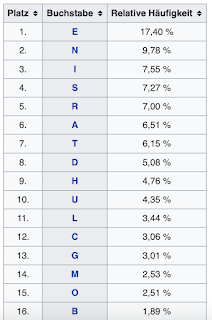Information content of single letter
Shannons Information-Theory is very concise when it comes about calculating the information content of a single letter a..z:
Source: https://de.wikipedia.org/wiki/Informationsgehalt
Source: https://de.wikipedia.org/wiki/Buchstabenhäufigkeit
So for example the delivered information of letter 'e' at the single appearance within the word 'household' can be calculated via:
But this information value does not respect the context of 'e' 's appearance. So if we regard another appearance of 'e' in the word 'enchiladas', the information content for 'e' would be the same 2.52 bit.
We can conclude: The information content calculation is based on the median appearance probability of the single isolated letter 'e' over a huge german text corpus (~17,4%).
Information content of a trigramm
If the letters within a language would appear independent of each other, then the appearance probability of a tri-gramm e.g. "die" could easily be calculated from the single-letter-appearance-probabilities "d", "i" and "e" by multiplication:
But it shows this is not the case:
Source: https://de.wikipedia.org/wiki/N-Gramm
So to correctly calculate the information content of a trigram you have to use the trigram probability:
Information of single letter contained within n-gram at position x
Now we want to answer the question from the headline: How can we calculate the information content of letter 'e' when contained and observed within a window of size 3, i.e. within an 3-gram?
Or to be even more exact: What's the information delivered by letter 'e' at position 2 (or 1 or 0) within a 3-gram?
Answer:
Step 0: get a file with all 3-gram frequencies (or alternatively absolute frequencies) in your language
Step 1: find all 3-grams where 'e' appears at position 2 (last position)
Step 2: Calculate the trigram-information content for every trigram and sum them up
Step 3: divide by 3, because that's the 'share belonging to 'e'' - every letter, that is part of the 3-gram get's the same 'share', i.e. a third
Code / Jupyter-Notebook
Source: https://github.com/hahnburg/redundancyandstructure/blob/master/4_Strukturelle_Redundanz_de.ipynb







Keine Kommentare:
Kommentar veröffentlichen